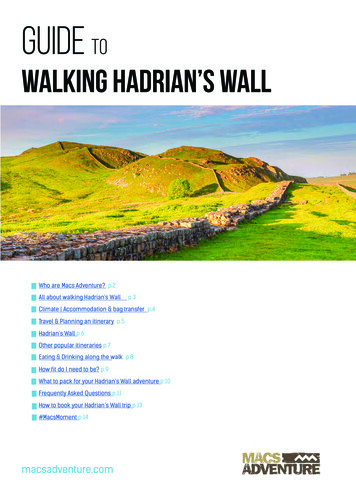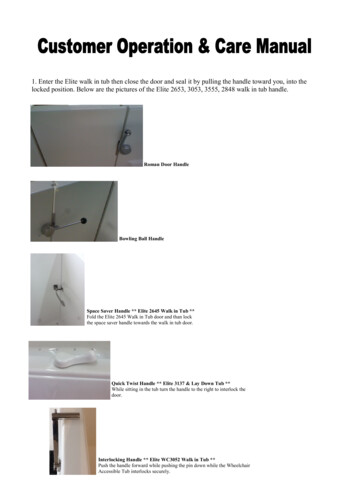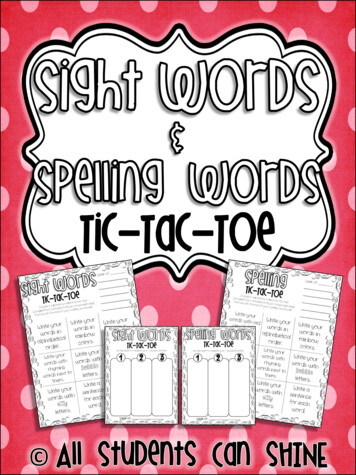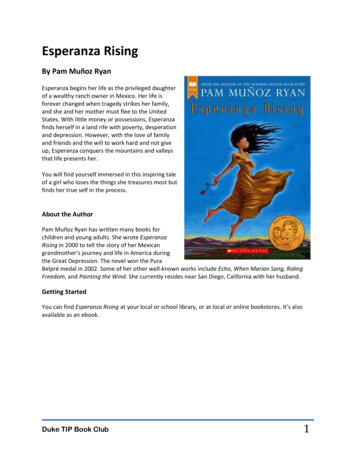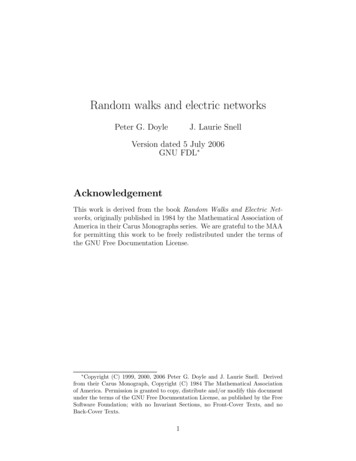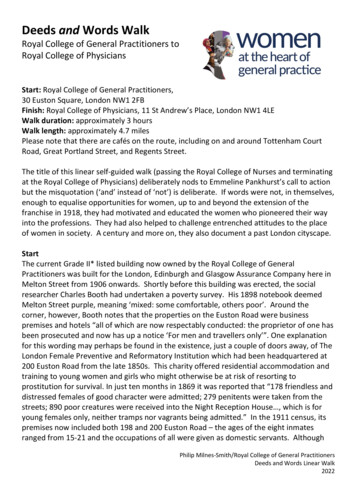
Transcription
Deeds and Words WalkRoyal College of General Practitioners toRoyal College of PhysiciansStart: Royal College of General Practitioners,30 Euston Square, London NW1 2FBFinish: Royal College of Physicians, 11 St Andrew’s Place, London NW1 4LEWalk duration: approximately 3 hoursWalk length: approximately 4.7 milesPlease note that there are cafés on the route, including on and around Tottenham CourtRoad, Great Portland Street, and Regents Street.The title of this linear self-guided walk (passing the Royal College of Nurses and terminatingat the Royal College of Physicians) deliberately nods to Emmeline Pankhurst’s call to actionbut the misquotation (‘and’ instead of ‘not’) is deliberate. If words were not, in themselves,enough to equalise opportunities for women, up to and beyond the extension of thefranchise in 1918, they had motivated and educated the women who pioneered their wayinto the professions. They had also helped to challenge entrenched attitudes to the placeof women in society. A century and more on, they also document a past London cityscape.StartThe current Grade II* listed building now owned by the Royal College of GeneralPractitioners was built for the London, Edinburgh and Glasgow Assurance Company here inMelton Street from 1906 onwards. Shortly before this building was erected, the socialresearcher Charles Booth had undertaken a poverty survey. His 1898 notebook deemedMelton Street purple, meaning ‘mixed: some comfortable, others poor’. Around thecorner, however, Booth notes that the properties on the Euston Road were businesspremises and hotels “all of which are now respectably conducted: the proprietor of one hasbeen prosecuted and now has up a notice ‘For men and travellers only’”. One explanationfor this wording may perhaps be found in the existence, just a couple of doors away, of TheLondon Female Preventive and Reformatory Institution which had been headquartered at200 Euston Road from the late 1850s. This charity offered residential accommodation andtraining to young women and girls who might otherwise be at risk of resorting toprostitution for survival. In just ten months in 1869 it was reported that “178 friendless anddistressed females of good character were admitted; 279 penitents were taken from thestreets; 890 poor creatures were received into the Night Reception House , which is foryoung females only, neither tramps nor vagrants being admitted.” In the 1911 census, itspremises now included both 198 and 200 Euston Road – the ages of the eight inmatesranged from 15-21 and the occupations of all were given as domestic servants. AlthoughPhilip Milnes-Smith/Royal College of General PractitionersDeeds and Words Linear Walk2022
we have celebrated the centenary of the extension of the franchise in 1918, it should benoted that even the two staff here, already over 30 years of age, may not have benefited asthere was still a property qualification for women that did not apply to men.Friends House, diagonally opposite from the College, was built on part of Endsleigh Gardensin the mid-1920s as a national headquarters for the Quaker movement. As crossing theEuston Road safely is difficult, it is recommended that you cross Melton Street first, andthen Euston Road at the pedestrian lights, walking East along the Euston Road towards thegardens. The Society of Friends had an egalitarian reputation and prominent individualsthough the generations have been advocates of social reform, such as campaigning toabolish slavery. However, the suffrage question was not a cause that found universalapproval, particularly when more violent means were to be used. Nonetheless, MabelRichmond Brailsford (1875-1970) would explore the historic experiences of non-conformingwomen confronting the state through the lens of contemporary experience in her QuakerWomen 1650-1690 published in 1915.Alice Clark (1874-1934), however, was a Quaker executive committee member of theNational Union of Women’s Suffrage Societies, who studied at the London School ofEconomics on a scholarship open only to women. She participated in the Great Pilgrimageof 1913 with a banner made by her sister Esther. Another sister, Hilda (1855-1955) was adoctor who had successfully treated her for tuberculosis in 1910. Hilda went on to foundthe Friends War Victims Relief Committee, and to champion other humanitarian causes.She is buried with her friend Edith Pye, a future President of the Royal College of Obstetricsand Gynaecology, with whom she had established a maternity hospital close to the WesternFront between 1914 and 1918.Turn right through the garden which has some key events in Quaker historycommemorated on the path, including a mention for the prison reformer Elizabeth Fry (néeGurney, 1780-1845), and a Quaker campaign for same-sex marriage. Emerging intoEndsleigh Gardens, turn left and then first right into Endsleigh Street.From 1913, number 14 Endsleigh Street was the home of Jessie Margaret Murray (18671920) and her friend, colleague, and putative partner Julia Turner (18631946) whom she had mentored into the medical profession. It also servedas the initial consulting space of their Medico-Pyschological Clinic. Bothwomen were members of the Women’s Freedom League and Jessie of theWomen’s Tax Resistance League. Although Jessie donated funds to allowother members to buy back furniture that had been seized to cover taxdebts, she refused to benefit from this herself. She also wrote the prefaceto Married Love, published by Marie Stopes (1880-1958) in 1918, noting that “it iscalculated to prevent many of those mistakes which wreck the happiness of countlessPhilip Milnes-Smith/Royal College of General PractitionersDeeds and Words Linear Walk2022
lovers as soon as they are actually married.” Jessie had also co-authored, with the journalistHenry Noel Brailsford (brother of Mabel, and member of the Men’s League for Women’sSuffrage), The Treatment of Women's Deputations by the Metropolitan Police. This was areport on the police violence against women during the Black Friday March of November1910. A deputation of women that had included Elizabeth Garrett Anderson (1836-1917),now in her mid-seventies, had been subject to aggressive policing. The Brailsford report’scall for a public inquiry was ignored by the Home Secretary, one Winston Churchill.Retrace your steps back to Endsleigh Gardens and turn left. Cross Gordon Street intoGower Place and stop at Gower Court. There were scientific laboratoriesat this corner of the main campus in the early twentieth century. It wasalleged by two visiting Swedish women students (ordinarily studying atthe London School of Medicine for Women, hereinafter LSMW), that, inone of them a dog was used in multiple experiments, that it was notanaesthetised and was in distress (to the amusement of the malestudents). The testimony of Emilie Augusta Louise "Lizzy" Lind af Hageby(1878-1963) and Leisa Katherina Schartau (1876-1962), prompted apublic speech by Stephen Coleridge. Although a subsequent libel action found againstColeridge, public decency had been outraged by the ‘Brown Dog Affair’, resulting in thesecond Royal Commission on Vivisection, and also the (controversial) erection, in 1906, of amemorial to the dog in Battersea Park, paid for by public subscription. ‘Fallist’ malemedical students sought to destroy the statue of the dog and have it thrown in the Thames.This burdened the local council with the substantial cost of round the clock policeprotection and rather than ‘retain and explain’, it was quietly taken down by the councilovernight in 1910 and secretly disposed of.However, the outraged students also disturbed suffragist meetings, including one organisedby Millicent Fawcett. From this distance of time, it may not seem obvious that women’srights and animal rights should go together, but in many ways their causes were alikebecause neither were deemed “persons”. Although there was not a complete crossoverbetween opposition to vivisection and advancing the cause of women’s suffrage, it wascertainly not surprising that students from the LSMW (which did not employ vivisection)were politically engaged, and, indeed, Lizzy Lind would become a member of the Women’sFreedom League as well as founding the Animal Defence and Anti-Vivisection Society. Alsoprominent in support of the brown dog statue was the so-called ‘Mother of Battersea’Charlotte Despard (née French, 1844-1939), a founder member of the Women’s FreedomLeague. We might also note a footnote in a mock-scholarly biography of a dog, by VirginiaWoolf (née Stephen, 1882-1941) which mentions “the inscrutable, the all-but-silent, the allbut-invisible servant maids of history” whose lives were less easily recovered than those oftheir mistresses’ pets.Philip Milnes-Smith/Royal College of General PractitionersDeeds and Words Linear Walk2022
The National Anti-Vivisection Society, of which Coleridge was secretary, had been foundedby Frances Power Cobbe (1822-1904) in 1875. Cobbe had also served on committeesadvocating for women’s rights, including the right to vote, and also espoused them in herjournalism. Her article Wife torture in England observes that the human male was “the onlyanimal in creation which maltreats its mate”, unfavourably contrasting bestial humancruelty with canine gentlemanliness, for example. After the second Royal Commissionreported, UCL’s Professor of Anatomy, George Dancer Thane was dissuaded from steppingdown as a vivisection inspector by Churchill’s successor as Home Secretary ReginaldMcKenna – the same man who defended the force-feeding of hunger striking suffragettesas “necessary medical treatment”.Walk to the end of the street and turn left into Gower Street. Cross it at the lights and turnright into Grafton Way, and cross it, turning right. Stop opposite the entrance to theElizabeth Garrett Anderson wing of University College Hospital. No longer staffedexclusively by women, this is the successor to the defunct New Hospital forWomen renamed after her in 1918, an institution which originated as her StMary’s Dispensary, near Marble Arch, which opened in 1866. Four yearsbefore that, while Elizabeth Garret was fighting the establishment tobecome the first openly female medical practitioner licensed in the UK,Frances Power Cobbe had noted that no man would dream of presentingthemselves for advice or treatment for a cold or cut finger to “hisgrandfather, or his uncle, his butler or footman,” adding that “Doctoring is one of the ‘rightsof women’ [I]f patients choose to go for advice to women, and women inspire them withsufficient confidence to be consulted, it is a piece of interference quite anomalous in ourday to prevent the woman qualifying herself legally.” In 1891, objecting to the idea thatemancipation meant becoming like men, Elizabeth’s sister Millicent Garrett Fawcett, notedof the New Hospital for Women, “Not only from the immediate neighbourhood but alsofrom the far East of London do they come because “the ladies” as they call them showtheir poor patients womanly sympathy, gentleness and patience, womanly insight andthoughtfulness in little things, and consideration for their home troubles and necessities.”Take the next left into Huntley Street and keep walking to the far end, crossing bothUniversity Street and Torrington Place and stopping at the junction with Chenies Street. Onyour right are the Chenies Street Chambers constructed and administered by the LadiesDwelling Company. On the board were Elizabeth Garrett’s sisterAgnes and cousin Rhoda, both suffragists. These dwellings firstopened round the corner in 1889 and were so popular that adjacentpremises here in Huntley Street were added by 1897, affordingresidents a communal club room/dining room in the basement. TheCompany built a further block in York Street, Marylebone in 1892,where Edith Shove (1848-1929) would live for more than a decade.Philip Milnes-Smith/Royal College of General PractitionersDeeds and Words Linear Walk2022
She had been the first woman doctor given a public appointment, as medical officerresponsible for the women in the Post Office, an appointment made by Henry Fawcett(husband of Millicent).During the lifetime of the Company, these flats might only be occupied by singleprofessional women and the only man habitually on the premises was the Hall Porter (whowas, of course, respectably married). In flat 5 in the 1911 census we find Edith SophiaHooper a writer, self-identified as a member of the National Union of Women’s SuffrageSocieties, refusing to participate “as a double protest against the government’s denial ofthe vote to duly qualified women, and its refusal, through the home secretary, of anenquiry into the treatment of the women on deputation by the police in November 1910.”Another significant woman who had resided here was Mary Louisa Gordon (1861-1941),recorded here as a General Practitioner in 1891. She would go on to be the first womanPrisons Inspector, and refused to resign when it emerged, from a police raid of the WSPU,that she had been in clandestine correspondence with Emmeline Pankhurst. Her 1936novel about the women of Llangollen notes “No one thinks it remarkable now if two friendsprefer to live together. They do so all over the country.” One such pair living here in 1911were medical students at the London School of Medicine for Women, Mildred BlancheStogdon (1875-1964), and Gertrude Brooks (1875-?1960), subsequently an anaesthetist.Gertrude and Mildred’s joint London practice at 2 Seymour Place (now Seymour Walk),does not appear in medical directories after the mid-1920s, and it may be then that theyremoved to Ringmer, Sussex, where they were still living together according to the 1939Register.Mary Gordon’s neighbours in 1891 had included both a medical student at the LSMW andanother graduate. The student was Ethel Mary Nucella Williams (1863-1948), who went onto be the first woman doctor in Newcastle upon Tyne and its first woman generalpractitioner and was co-founder of the Northern Women’s Hospital and was a suffragist.She too would choose to live with her friend – the mathematician Frances Hardcastle(1866-1941). The graduate was Margaret Mary Sharpe (1854-?1926) who would go on topublish articles in the journal Archives of the Roentgen Ray, and whom the censusenumerator somewhat misleadingly claims to be “practising as electrician”. She was asignatory of the 1905 Petition to the central educational authorities of England, Wales,Scotland & Ireland, distributed to the medical profession of the United Kingdom, advocatinghealth education in schools, including with reference to alcohol.Turn right into Chenies Street and, at the end, cross Tottenham Court Road. Watch out forfire engines: the Geordie suffragette Kathleen Brown (1886-1973) reportedlycommandeered one for the cause, driving it along this very road, during one of her visits toLondon. Imprisoned for her activism three times, she went on hunger strike in bothNewcastle and London. After Kathleen’s first hunger strike, she was examined by the GPEthel Bentham (1861-1931), formerly the first practice partner of Ethel Williams. As aPhilip Milnes-Smith/Royal College of General PractitionersDeeds and Words Linear Walk2022
result, Ethel (Bentham) wrote of her concerns about prison conditions to the HomeSecretary.Turning north up Tottenham Court Road, stop at the corner of Tottenham Street (first left),looking north. Hilda Margaret Byles (1879-1931) was a worshipper at what is now theAmerican Church when she was studying at the LSMW. Only seven years after the Boxerrebellion of 1900 and relatively recently qualified, this “little woman of amazing energy andcapabilities” left England to lead the women’s section of the Renji Hospital in Hankou,Wuhan, China, where she spent the rest of her career.Just beyond the Church, police intelligence, in 1912, suggested that suffragettes were usinga shooting range at number 92 to practise their marks[wo]manship with a view toassassination, but it is far from clear that any plot actually existed beyond the imaginationof the informant and the police force. Emmeline Pankhurst that year countering objectionsto activists supposedly endangering the lives of others, observed, “There is something thatgovernments care far more for than human life, and that is the security of property”, theendangerment of which had, in her view, even if not immediately, secured voting rights forworking men. What followed was the Suffragette campaign targeting pillar-boxes, practicalitems of street furniture used symbolically in the writing of Virginia Woolf: the posting of aletter was a legitimate reason for a patriarchally controlled middle-class woman to be in thestreets, unescorted because close to home, but it could also represent that patriarchy.Turn left along Tottenham Street, crossing first Whitfield Street and then Charlotte Street,turning back to look across the street to the corner of Tottenham and Charlotte Streets.The Scala Theatre once stood here (giving its name to nearby ScalaStreet). Long before it featured in the Beatles’ film A hard day’s night, itwas the venue for the premiere performance of A Pageant of GreatWomen in 1909. Written by Cicely Mary Hamilton (1872-1952), cofounder of the Women Writers’ Suffrage League, in collaboration withEdith Craig (1869-1947) of the Actresses Franchise League who directed and performed init, this morality play introduced a cast of significant women from history as evidence againstPrejudice (the only part given to a male actor). Scientific figures include FlorenceNightingale and Marie Curie, who had won the Nobel Prize in 1903, and “the girl graduateof a modern day, working with man as eagerly and hard, and oft enough denied a man’sreward.” There are clearly some cross-overs between the show and Votes for Womenprocessions, such as that witnessed by Ruth Slate the previous year featuring “MadameCurie, Black Agnes of Dunbar, Joan of Arc, Boadicea.” Ruth added “I could not name half”which may suggest an educational motive for the entertainment, which went on to be verypopular around the country. Edith Craig said, “Plays have done such a lot for the Suffrage.They get hold of nice, frivolous people who would die sooner than go in cold blood toPhilip Milnes-Smith/Royal College of General PractitionersDeeds and Words Linear Walk2022
meetings. But they watch the plays, and get interested, and then we can rope them in formeetings.”Another AFL/WWSL production staged here that year was Cicely Hamilton and ChristopherSt John’s Pot and Kettle, which exposed the hypocrisy of using violence to object to the useof violence in the suffrage cause. Christopher Marie St John (1871-1960) had been bornChristabel Gertrude Marshall, and she had been in a relationship with Edith Craig since1899. A third woman would join their household in 1916, the artist Clare ‘Tony’ Atwood(1866-1962).Head north up Charlotte Street, stop at the junction with Chitty Street.Look west across the road, to the approximate site of number 51, thefounding hostel of Mary Jane Kinnaird’s YWCA, which was in the words ofBaroness Burdett Coutts “a Home in which young women above the rankof domestic servants were boarded and lodged for a guinea a week. Sometwo years later this Home altered its character. Rooms were thrown openevery evening except Saturday, for the use of young women engaged in business during theday, who were invited to make use of a good library, to join classes for French, German,singing, drawing, and to listen to lectures on various subjects.” The original idea for ahostel seems to have been connected with Mary’s interest in housing nurses stopping off inLondon en route for service in the Crimea.Turn right into Chitty Street and then left up Whitfield Street, stopping opposite number108, identified by the blue plaque as the second location of the first birthcontrol clinic. A eugenicist, Marie Stopes (1880-1958) had been a studentat UCL in botany and geology, and subsequently conducted palaeobotanical research. The free ‘Mother’s Clinic’, here, used midwives toadvise on birth control, and teach contraceptive techniques, with themotive of promoting the health and well-being of mothers, and preventing abortions,somewhat like the centres, advocated by the Women’s Co-operative League, where“expectant and nursing mothers. can come for advice and treatment so that they may bekept well and made well.”At the end of the street, turn right into Grafton Way and stop outside number 58. As theblue plaque notes, this was the home of Francisco di Miranda. The army surgeon JamesMiranda Steuart Barry was revealed to be physically female when thecorpse was being prepared for burial. Born Margaret Ann Bulkley (c.17891865) it seems likely that the second forename was adopted in Francisco’shonour, and the library here may well have helped with preparations foruniversity study. It has been suggested that had Francisco not beenarrested, the original plan had been for her James to revert back toMargaret en route to a medical career in Venezuela. James Barry, qualifiedPhilip Milnes-Smith/Royal College of General PractitionersDeeds and Words Linear Walk2022
as a doctor in Edinburgh in 1812, more than fifty years before the Surgeon’s Hall Riot, andin London as a surgeon the following year, nearly a hundred years before Eleanor DaviesColley (1874-1934) became the first woman fellow of the Royal College of Surgeons.Head back west along Grafton Way and take the second right turn into FitzroySquare. Stop outside number 4, which housed The Female Medical College,later known as The Obstetrical College for Women. Founded in 1864 by DrJames Edmund the aim of this institution, despite its name, was merely totrain educated women as midwives. Isabel Thorne (née Pryer, 1834-1910),Matilda Charlotte Chaplin Ayrton (née Chaplin, c.1846-1883) and Alice Vickery(1844-1929) had training here, before undertaking more complete medical training.Alice was the first woman to qualify as a Chemist and Druggist through the PharmaceuticalSociety’s exam in 1873 and was one of the first five women to qualify from the LSMW.Another eugenicist, who advocated birth control, she was also a suffrage campaignerthrough successively the National Society for Women’s Suffrage, the Women’s Social andPolitical Union (hereinafter WSPU) and the Women’s Freedom League. Although she was ina longstanding relationship that contemporaries took to be marriage, neither partnerbelieved in the institution. Matilda was one of the Edinburgh Seven, accepted as MedicalStudents in that city, an innovation that provoked a riot in 1870, but not permitted tograduate, who subsequently qualified in Paris. Isabel was another of the Edinburgh Sevenbut never fully qualified as a doctor, instead serving as administrator of the LSMW from1877-1908. Within a couple of years of this College opening, Elizabeth Garrett was anxiousnot to be associated with it, and she refused to give its students clinical experience at theNew Hospital for Women.Continue round the north and west sides of the square and stop outside number 29 wherea plaque commemorates the residence here of Virginia Woolf between 1907 and 1911. Inher final months here, and still an unpublished novelist she confided to her sister“all the devils came out—hairy black ones. To be 29 and unmarried—to be afailure—childless—insane too, no writer.” Nearly two decades later, writingabout the middle-class women of the previous century she would contrast theiropportunities with those of their male contemporaries, noting “the age at whichthey married, the number of children they bore, the privacy they lacked andthe education they never received,” and singled out Elizabeth Garrett who“became a doctor because her parents, though shocked and anxious, would bereconciled if she were a success.”The other plaque here mentions George Bernard Shaw, who wrote "Unless womanrepudiates her womanliness, her duty to her husband, to her children, to society, to thelaw, and to everyone but herself, she cannot emancipate herself.” He left this home when,Philip Milnes-Smith/Royal College of General PractitionersDeeds and Words Linear Walk2022
in 1898, he married a self-effacing heiress who had, in his words, “cleverness and characterenough to decline the station in life.” Charlotte Frances Townshend-Payne (1857-1943) wasan early benefactor of the London School of Economics and would go on to establish thewomen only scholarship awarded to Alice Clark, whom we met at Friends House. Charlottehad, in fact, proposed first and been rejected partly from his fear of being considered asponging fortune-hunter, but he relented and proposed to her when she helped save hislife: “I thought I was dead, for it would not heal, and Charlotte had me at her mercy. Ishould never have married if I had thought I should get well.” Her prior nursing experiencedoubtless helped ensure his recovery from the bone necrosis in his foot, and the arm hesubsequently broke during his convalescence, but she went on to be his collaborator andco-creator.On the south side of the Square to the right of the plaque commemorating (the architectRobert Adam) is number 36. In 1848 this was the home of St John’s House,offering training for nurses. By 1854, when it had already located to Queen’sSquare, it sent six nurses to the Crimea with Florence Nightingale. Theinstitution, though in some ways a religious order, would go on to supply thenurses of King’s College Hospital from 1856 and the Charing Cross Hospitalfrom 1866.Turn back towards Grafton Way and turn right down Fitzroy Street, passing the statue ofFrancisco di Miranda, and stopping outside number 27. In the 1880s, this was the home ofthe Black sisters (Clementina, Emma, Grace and Constance), Brighton-bornbut of Russian descent, all of whom were users of the British Museumreading room: Constance (1861-1946) had briefly been a librarian, andpromoted the career for women, but became a translator of Russianliterature; Clementina wrote novels, but was also a social activist, joiningthe Women’s Protective and Provident League, the Women’s Trade UnionAssociation, Women’s Labour League, the Anti-Sweating League and theNational Union of Women’s Suffrage Societies. She was also honorarysecretary of the Women’s Franchise Declaration Committee which compiled another of themany suffrage petitions. Her publication Married Women’s Work, for the Women’s LabourLeague, reports on living and working conditions across the country from 1909-1910, withClementina herself contributing the chapter on London (with sections on, among others,laundresses, glove-makers, quilt makers, sewers of furs, carpets and sacks, artificial flowermakers, tennis and racquetball coverers, artificial flower makers, feather curlers, milliners,jam and preserve makers, paper bag makers, tie makers and a variety of clothing trades).Further south down this street, at number 19, there was a short-lived (1890-1892)International School for the children of political refugees. If this sounds run of the milleducational philanthropy, it wasn’t. Louise Michel (1830-1905), the founder, was a Frenchanarchist, in exile. A member of a society campaigning for women’s education, she hadPhilip Milnes-Smith/Royal College of General PractitionersDeeds and Words Linear Walk2022
headed the Montmartre Women’s Vigilance Committee during the Paris Commune in 1871,and this school was designed to produce “free and noble-minded men and women, notcommercial machines.” The school was closed down following the revelation that therewere bombs in the basement. However, it is important to note that the person responsiblefor stashing them there was a Metropolitan Police Special Branch agent provocateur whohad offered his services to the school in order to facilitate surveillance, and who hadalready been asked to resign.Further down the street, close to the junction with Howland Street, once stood premises,at number 5, and later number 7, used by the College for WorkingWomen, which had broken away from the Working Women’sCollege in 1874 under the direction of Frances Martin (1829-1922).Her view was that “it is not only the fallen, the degraded, thedestitute, who have claims upon us; that quite as urgent andimperative are the demands of the great army of virtuous workers” intent on improvingtheir employment prospects – just such women, in other words, as Clementina Black wouldwrite about. It offered evening classes in mathematics, languages, science, history and thearts. Frances had contributed to the successful campaign to elect Elizabeth Garrett to theLondon School Board in 1870. In 1878, Elizabeth recommended Emily Bovell Sturge (18411885) as a lecturer on physiology and hygiene. The College had its social side, and LouisaGarrett Anderson organised the monthly dances in the early 1890s, by which time it hadbeen offering for a decade “a holiday guild, a sick benefit club and a penny bank.”Turn right into Howland Street and cross Cleveland Street, stoppingopposite the BT tower. The Cleveland Hall once stood here. After aperiod when it was used by anarchists (including Louise Michel) andinternational revolutionists it had reopened through the LondonMethodist Mission in 1890. This was where Clara Sophia ‘Mary’ Neal(1860-1944) and Emmeline Pethick (1867-1954) met, running a clubhere for working class girls. They went on to found the EsperanceGirls’ Club together. We’ll meet them again later, towards the end of the walk.Walk south down Cleveland Street and stop just before the King and Queen public house(on the right). Here in 1910, the West London Mission in the name of thephilanthropist Emerson Bainbridge established a Hostel for Young Women andGirls and, in separate but adjacent premises, a hostel for Fallen Women.It faced the buildings of the Strand Union workhouse. Thiswas already fifty years old when Charles Dickens livednearby as a teenager, when working at the B
Retrace your steps back to Endsleigh Gardens and turn left. Cross Gordon Street into Gower Place and stop at Gower Court. There were scientific laboratories . certainly not surprising that students from the LSMW (which did not employ vivisection) were politically engaged, and, indeed, Lizzy Lind would become a member of the Women's .

